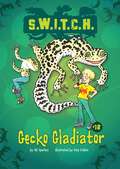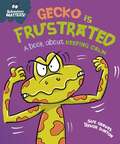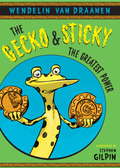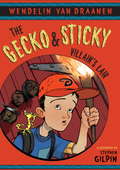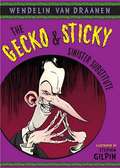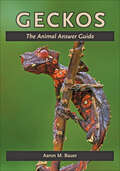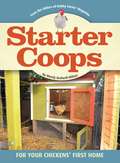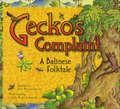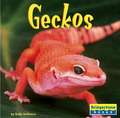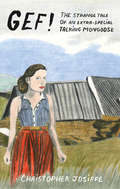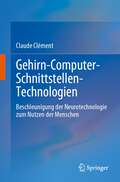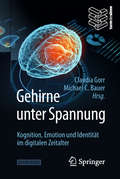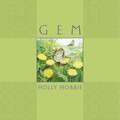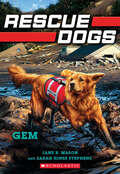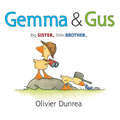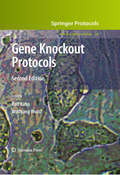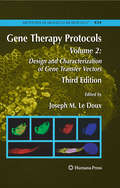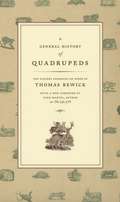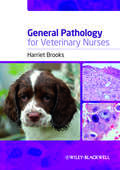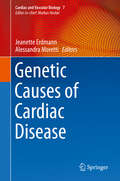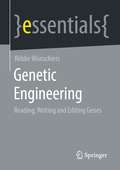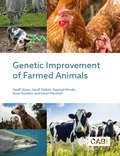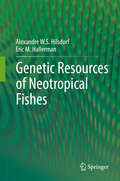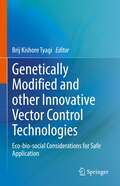- Table View
- List View
Gecko Gladiator (S.W.I.T.C.H. #12)
by Ali SparkesJosh and Danny are stuck in Princess Land—a store full of pink toys and worse: actual girls! To avoid security guards and screeching girls, the twins try a quick spritz of the infamous S.W.I.T.C.H. formula. But the spray only half-works! They are stuck with the head of a lizard and the body of a boy. Then their situation takes a nasty turn...
Gecko is Frustrated - A book about keeping calm (Behaviour Matters)
by Sue GravesGecko is Frustrated offers a gentle introduction to the concept of frustration for young children, helping them find ways to recognise and deal with their frustrated feelings.This funny, charming story is the perfect way to introduce young children to frustration. Also included are suggestions for activities and ideas to talk through together to help children understand their behaviour.Gecko often feels frustrated - when he has to wait or finds something difficult to do. When his frustration gets the better of him, he upsets Hippo. Gecko is sad. Can he find ways to manage his frustration and keep calm?The Behaviour Matters series of picture books provide a gentle means of discussing emotions, boosting self-esteem and reinforcing good behaviour. Supports the Personal, Social and Emotional Development Area of Learning in the Early Years Foundation Stage, and is also suitable for use with children in KS1 and can be used to discuss values. Suitable for children under 5.
The Gecko & Sticky #1: The Greatest Power
by Wendelin Van DraanenCould you choose between a superpower and a friend? The evil treasure hunter Damien Black needs some quick cash--so he robs the local bank. But Damien Black didn't figure Dave Sanchez into his plan. Dave's been itching to try out the Invisibility Ingot in his magical wrist band, and here's the perfect opportunity to make like a superhero! So Dave and Sticky set off after the robber, determined to retrieve the bank's money. The Black mansion is a house of hysterical horrors, but somehow he and Sticky manage to navigate the maze and escape with the cash. Asombroso!Dave thinks he's home free, but Damien Black isn't one to give up easily--more than the cash, he wants Dave's wrist band, and he's got a dastardly devious plan that even an invisible boy won't be able to slip out of. From the Hardcover edition.
The Gecko & Sticky #2: Villain's Lair
by Wendelin Van DraanenFilled with outrageous adventures, over-the-top characters, and snappy dialogue, this new series featuring a boy and his talking pet gecko is sure to be a hit with young superheroes everywhere.
The Gecko & Sticky #3: Sinister Substitute
by Wendelin Van DraanenDave's most despised teacher, a gleeful frog dissector named Ms. Veronica Krockle, is absent. Her students are psyched! But Sticky is suspicious. Especially when the substitute teacher turns out to be strangely interested in geckos. Or rather, boys with pet geckos. That's no substitute! That's Damien Black, dastardly treasure hunter and master of disguise! If Damien Black is in school, does that mean he's behind Ms. Krockle's absence? Could she have been kidnapped? And does that mean Dave has to rescue her? Ay chihuahua! The capped crusader is (reluctantly) on the case.
Geckos: The Animal Answer Guide (The Animal Answer Guides: Q&A for the Curious Naturalist)
by Aaron M. BauerEverything a student, naturalist, or curious observer wants to know about the biology and diversity of geckos.Q: How do geckos walk across ceilings? A: Millions of hair-like setae on each foot.Q: Where do geckos come from? A: Throughout the world. Usually where it’s warm.Q: How many species of geckos are there? A: Close to 1,500 and counting!Q: What do they eat? A: Insects mostly. Discover the biology, natural history, and diversity of geckos—the acrobatic little lizards made famous by a car insurance ad campaign. Lizard biologist and gecko expert Aaron Bauer answers deceptively simple questions with surprising and little-known facts. Readers can explore color photographs that reveal the natural wonder and beauty of the gecko form and are further informed by images of how geckos live in their natural habitats. Although written for nonexperts, Geckos also provides a carefully selected bibliography and a new list of all known species that will be of interest to herpetologists. Anyone who owns a gecko, has seen them in the wild, or has wondered about them will appreciate this gem of a book.
Geckos
by Juile BergmanEditor Julie Bergman states in her introduction to Geckos that the purpose of this book is "to provide the reader with a straightforward, practical source of information on selecting and keeping geckos." Her colorful guide achieves that aim and more, as it offers an authoritative overview of the many geckos available today, including the extremely popular leopard gecko and crested gecko as well as various day geckos, Madagascan geckos, new Caledonian geckos, micro-geckos, and tokay geckos. For their amazing colors, interesting behaviors, longevity, and attractive appearance, geckos are favored by beginning hobbyists. Colorfully illustrated, Geckos provides guidelines for keepers who wish to add a gecko to their vivarium and maintain their pet in excellent health and condition. The editor provides an introduction to gecko characteristics including size, feet, eyes, color and pattern, scales, shedding, reproduction, tail, sexing and activity, to help beginners better understand the anatomy and behavior of these fascinating lizards. This Advanced Vivarium Systems title includes information about selecting a healthy gecko, handling, housing needs, water and feeding requirements. A separate chapter "Keeping Geckos Healthy" provides a complete primer on the health needs and veterinary care of these rewarding reptiles, including quarantine and acclimation considerations, stress, parasites, and specific disorders.
Gecko's Complaint
by Ann Martin BowlerThis colorfully illustrated multicultural children's book presents a classic Balinese fairy tale—providing an entertaining look into a rich oral tradition. Featured as a "Top Pick" on TravelForKids. com,Gecko's Complaint tells the story of a Gecko who once lived on the island we now call Bali, in a jungle dense with flowers and vines. After hundreds of fireflies disturb Gecko's sleep, he complains to kindly Raden, the jungle's lion leader. In his efforts to get to the bottom of Gecko's troubles, Raden discovers all too much complaining and far too many irritable animals. Can Raden help the animals with their troubles? Can peace and happiness return to the jungles of Bali? A simple yet absolutely delightful Balinese folktale for kids, this bilingual edition, which features both English and Indonesian text, is a perfect introduction to the true spirit of Bali. The Indonesian island of Bali has a strong art and storytelling tradition—folktales that have been passed down from generation to generation. As a nation with over 18,000 islands, Indonesia has hundreds of traditional languages and cultures, each with myths and legends to tell. With its backdrop ofvolcanoes, earthquakes, dense jungles, diverse wildlife and people, it is not surprising that Indonesia is rich with fabulous, imaginative tales.
Geckos (World of Reptiles)
by Sally VelthausProvides an introduction to geckos, discussing their characteristics, habitat, food, offspring, and dangers.
Gef!: The Strange Tale of an Extra-Special Talking Mongoose
by Christopher JosiffeAn exhaustive investigation of the case of Gef, a &“talking mongoose&” or &“man-weasel,&” who appeared to a family living on the Isle of Man.&“I am the fifth dimension! I am the eighth wonder of the world!&”During the mid-1930s, British and overseas newspapers were full of incredible stories about Gef, a &“talking mongoose&” or &“man-weasel&” who had allegedly appeared in the home of the Irvings, a farming family in a remote district of the Isle of Man. The creature was said to speak in several languages, to sing, to steal objects from nearby farms, and to eavesdrop on local people.Despite written reports, magazine articles and books, several photographs, fur samples and paw prints, voluminous correspondence, and signed eyewitness statements, there is still no consensus as to what was really happening to the Irving family.Was it a hoax? An extreme case of folie à plusieurs? A poltergeist? The possession of an animal by an evil spirit? Now you can read all the evidence and decide for yourself. Seven years' research and interviews, photographs (many previously unseen), interviews with surviving witnesses, visits to the site—all are presented in this book, the first examination of the case for seventy years.In the words of its mischievous, enigmatic subject, &“If you knew what I know, you'd know a hell of a lot!"
Gehirn-Computer-Schnittstellen-Technologien: Beschleunigung der Neurotechnologie zum Nutzen der Menschen
by Claude ClémentDieses Buch befasst sich mit dem Bereich der Gehirn-Computer-Schnittstellen (BCI) und dem einzigartigen und besonderen Umfeld aktiver Implantate, die eine elektrische Schnittstelle zum Gehirn, zum Rückenmark, zu peripheren Nerven und zu Organen bilden. Im Mittelpunkt des Buches steht die Heilung und Rehabilitation von Patienten mit schweren neurologischen Beeinträchtigungen, von Lähmungen bis hin zu Bewegungsstörungen und Epilepsie, die oft eine invasive Lösung auf der Grundlage eines implantierten Geräts erfordern. Frühere Errungenschaften, aktuelle Arbeiten und Zukunftsperspektiven von BCI und anderen Interaktionen zwischen medizinischen Geräten und dem menschlichen Nervensystem werden aus pragmatischer Sicht ausführlich beschrieben. gibt einen Überblick über die Branche der aktiven implantierbaren medizinischen Geräte (AIMDs) und wie sie sich von kardialen zu neurologischen Anwendungen entwickelt Klare, leicht zu lesende Darstellung des Bereichs der Neurotechnologien zum Nutzen des Menschen Bietet leicht verständliche Erklärungen zu den technischen Grenzen, den physikalischen Eigenschaften von Implantaten im menschlichen Körper und realistischen langfristigen Perspektiven
Gehirn und Kunst: Von der Ästhetik zur Therapeutik
by Bruno ColomboIn diesem Buch wird die Kunsttherapie, ein spezifisches Instrument zur Erhaltung der Gesundheit im Bereich der affektiven Entwicklung, der Rehabilitation, der Motorik und der kognitiven Funktionen, eingehend analysiert und diskutiert. Kunsttherapie basiert auf der Annahme, dass der Prozess des künstlerischen Schaffens – Musik, Tanz, Malerei – Emotionen auslöst und die Gehirnaktivität steigert. Sie wird eingesetzt, um das persönliche Wachstum zu fördern, bestimmte Gehirnbereiche oder Aktivitätsmuster zu unterstützen und die neuronale Vernetzung zu verbessern. Die Behandlung neurologischer Erkrankungen mit künstlerischen Strategien bietet uns eine einzigartige Möglichkeit, die strukturellen Netzwerke des Gehirns zu beeinflussen und die Fähigkeit des Gehirns zur Bildung neuer Verbindungen zu verbessern. Auf der Grundlage der Plastizität des Gehirns hat Kunsttherapie das Potenzial, unser Repertoire zur Behandlung neurologischer Erkrankungen zu erweitern. Neuronale Substrate sind die Grundlage komplexer Emotionen bei Kunsterfahrungen und gehen mit einer umfassenden Aktivierung kognitiver und motorischer Systeme einher. Dementsprechend vermag Kunsttherapie Verhalten, Kognition, Aufmerksamkeit und Bewegung zu modulieren. In diesem Zusammenhang kann die Kunsttherapie wirksame Instrumente zur Verbesserung des allgemeinen Wohlbefindens, der Lebensqualität und der Motivation im Zusammenhang mit neurologischen Erkrankungen bieten. Das Buch erörtert die Kunsttherapie als ein mögliches Verfahren zur Behandlung neurologischer Störungen und nähert sich dem Verhältnis zwischen humanistischen Disziplinen und der Neurologie aus einer ganzheitlichen Perspektive, die das wachsende Interesse an dieser Verzahnung widerspiegelt.Dieses Buch stellt eine Übersetzung einer ursprünglich englischsprachigen Ausgabe dar. Die Übersetzung wurde mithilfe von künstlicher Intelligenz vorgenommen (maschinelle Übersetzung durch DeepL.com). Eine anschließende menschliche Überarbeitung wurde vorwiegend im Hinblick auf den Inhalt durchgeführt, sodass sich das Buch sich stilistisch von einer herkömmlichen Übersetzung unterscheidet.
Gehirne unter Spannung: Kognition, Emotion und Identität im digitalen Zeitalter
by Claudia Gorr Michael C. BauerGehirne unter Spannung Die fortschreitende Digitalisierung verändert unsere Kommunikation, unsere Bildung, unser Sozialleben, nicht zuletzt unsere Wahrnehmung von uns selbst. Wie wirken sich diese Veränderungen inzwischen und zukünftig auf Gesellschaft, Familie und den Einzelnen aus? In welcher Weise beeinflussen WhatsApp, Facebook & Co. den Umgang mit Partnern, Freunden, aber auch uns fremden Netzwerk-Usern? Beschneiden soziale Medien und Algorithmen unsere Autonomie und Mündigkeit; wenn ja - wie können wir uns schützen? Auch im Bereich der Entwicklung künstlicher Intelligenz machen sich bahnbrechende Innovationen bemerkbar. Kann ein intelligentes System eigentlich Gefühle haben und was lernen wir vor allem daraus über uns selbst? Fragen wie diese stehen im Mittelpunkt dieses Buches, in dem renommierte Experten verschiedener Fachgebiete die Herausforderungen des digitalen Wandels für den Menschen beleuchten.
Gem
by Holly HobbieLook carefully. There may be a gem in your garden.For nearly four decades, watercolorist Holly Hobbie has drawn inspiration from the wonders of nature. During one especially hard winter, she found herself imagining the story of a determined toad's spring journey. Her vivid depiction of this endearing creature's glorious yet fragile world is a sparkling celebration of survival and renewal. From the muddy brown road outside a farmhouse to the sweet-smelling garden to the cool lily pads in the pond, readers will feel their senses rejuvenated by Holly Hobbie's gemlike, detailed paintings in this nearly wordless work.
Gem (Rescue Dogs #4)
by Jane B. Mason Sarah Hines-StephensGem is a golden retriever puppy who loves to dig. She gets adopted out to a handful of would-be forever families, but no matter how much she wants to please her new people, she can't keep herself from digging up the roses...and the lawn...and the couch cushions...anything that's remotely diggable. Over and over she is returned to the shelter, unwanted and heartbroken. The folks at the Sterling Center recognize Gem's flaw as an asset. A dog this driven could really shine in a disaster! But soon after she arrives at the training facility, Gem gets sick...really sick. Will she recover and stay healthy enough to save lives?
Gemma & Gus (Gossie & Friends)
by Olivier DunreaMeet Gemma and Gus, the newest characters in Olivier Dunrea’s irresistable Gossie & Friends series! Gemma is the big sister. Gus is the little brother. Gus is always following Gemma around, but one day Gus sets out on his own. Just who is following who? Another pair of darling goslings make their debut in this sweet story, with Olivier Dunrea’s perfectly pitched storytelling and endearing illustrations that Gossie & Friends fans have come to cherish.
Gene Knockout Protocols
by Ralf Kühn Wolfgang WurstWith the completion of the mouse and human genome sequences, the functional characterization of every mammalian gene and the deciphering of their molecular interaction network has become the next major challenge, and the mouse genome provides a convenient and vital model for these studies. In "Gene Knockout Protocols, Second Edition", distinguished contributors with extensive experience in the gene targeting and mouse genetics fields reveal a comprehensive collection of step-by-step laboratory protocols. Emphasizing the many new mutagenesis techniques developed over the last seven years, the volume covers topics such as gene modification in ES cells, stem cell manipulation, the generation of genetically engineered mice, and mutant phenotype analysis. Written in the highly successful Methods in Molecular BiologyTM series format, chapters contain brief introductions to their respective subjects, lists of the necessary materials and reagents, readily reproducible protocols, and notes on troubleshooting and avoiding known pitfalls. Fully updated and authoritative, "Gene Knockout Protocols, Second Edition" provides a unique collection of expert bench protocols certain to be a valuable resource for those just entering the field of gene targeting but also for all genetic researchers today.
Gene Therapy , Third Edition, Volume 2: Design and Characterization of Gene Transfer Vectors
by Joseph LedouxIn Gene Therapy Protocols, Volumes 1 & 2, internationally recognized investigators describe cutting-edge laboratory techniques for the study of Production and In Vivo Applications of Gene Transfer Vectors (Volume 1) and Design and Characterization of Gene Transfer Vectors (Volume 2). The field of gene therapy has undergone remarkable advances, promising to impact human healthcare significantly in the twenty-first century. Today’s technologies can deliver genetic material safely and effectively to cells to slow or halt the progression of disease, and to help repair or regenerate damaged or lost tissues. In this second volume of Gene Therapy Protocols: Design and Characterization of Gene Transfer Vectors, readers will find a comprehensive resource of current and emerging methods for the processing and characterization of viral and non-viral gene transfer vectors, as well as promising approaches to design vectors for efficient, targeted and regulated gene delivery and expression. This second volume of the new and completely revised third edition of Gene Therapy Protocols will prove a necessary tool for graduate students and postdoctoral fellows and invaluable to basic and clinical researchers in both industry and academia.
A General History of Quadrupeds: The Figures Engraved on Wood by Thomas Bewick
by Thomas BewickIn the late eighteenth century, the British took greater interest than ever before in observing and recording all aspects of the natural world. Travelers and colonists returning from far-flung lands provided dazzling accounts of such exotic creatures as elephants, baboons, and kangaroos. The engraver Thomas Bewick (1753–1828) harnessed this newfound interest by assembling the most comprehensive illustrated guide to nature of his day.A General History of Quadrupeds, first published in 1790, showcases Bewick’s groundbreaking engraving techniques that allowed text and images to be published on the same page. From anteaters to zebras, armadillos to wolverines, this delightful volume features engravings of over four hundred animals alongside descriptions of their characteristics as scientifically understood at the time. Quadrupeds reaffirms Bewick’s place in history as an incomparable illustrator, one whose influence on natural history and book printing still endures today.
General Pathology for Veterinary Nurses
by Harriet BrooksA good understanding of pathology will turn a competent veterinary nurse into an outstanding one. Harriet Brooks. This is one of the first books on general pathology designed specifically for veterinary nurses and veterinary nursing students. Pathology underpins all you do as a veterinary nurse. Knowledge of the general pathological processes will give you a deeper understanding of every aspect of an animal’s health. Building on your prior knowledge of anatomy, physiology and biochemistry, the book explains the pathological changes that occur in sick animals. It describes the various disease processes and shows you how to relate them to clinical presentation, diagnosis and prognosis, and treatment rationales. This book will give you the knowledge and confidence to develop your role within the veterinary team. Designed as a concise, easy to read textbook, it includes: Detailed illustrations to explain the science behind the pathological processes Summary boxes of key information to aid revision A ‘test yourself’ section at the end of each chapter
Genetic Causes of Cardiac Disease (Cardiac and Vascular Biology #7)
by Jeanette Erdmann Alessandra MorettiThis book provides a comprehensive summary of the latest developments in the field of the genomics of cardiac disease. Written and edited by leading clinicians and scientists involved in the analysis and therapy of genetic cardiac disorders, it discusses the genetic causes of a variety of cardiac diseases, such as the complex genetics and etiology of congenital heart diseases. It also explores sex differences in prevalent diseases, genetics-based therapeutic strategies and the use of various animal models and alternatives. The book is intended for research scientists and clinical scientists in the cardiovascular field, human geneticists and cardiologists.
Genetic Engineering: Reading, Writing and Editing Genes (essentials)
by Röbbe WünschiersThis essential should serve as an introduction for a contemporary public discussion on genetic engineering. Genetic engineering affects us all in many areas and we must dare to think more colorful and further. In fact, the complete genetic material of viruses and bacteria can already be chemically produced and "brought to life". With genetic surgery, medicine is at a crossroads: do we want to treat hereditary diseases or "repair" them genetically? And the analysis of thousands of human genetic material reveals information that is related to complex diseases, but also to characteristics such as intelligence. How should we use this knowledge? The question is hardly whether we want genetic engineering, but rather how we use it.This Springer essential is a translation of the original German 1st edition essentials, Gentechnik by Röbbe Wünschiers, published by The Editor(s) (if applicable) and The Author(s), under exclusive license to Springer Fachmedien Wiesbaden GmbH, part of Springer Nature in 2019. The translation was done with the help of artificial intelligence (machine translation by the service DeepL.com). A subsequent human revision was done primarily in terms of content, so that the book will read stylistically differently from a conventional translation. Springer Nature works continuously to further the development of tools for the production of books and on the related technologies to support the authors.
Genetic Improvement of Farmed Animals
by Geoff Simm Dr Geoff Pollott Raphael A Mrode Professor Ross Houston Dr Karen MarshallGenetic Improvement of Farmed Animals provides a thorough grounding in the basic sciences underpinning farmed animal breeding. Relating science to practical application, it covers all the major farmed animal species: cattle, sheep, goats, poultry, pigs and aquaculture species. The book: - Provides comprehensive coverage - from fundamental genetics, analysis of variation, prediction of breeding values and response to selection, through to application of modern genomics and biotechnology. - Illustrates the practical application of theory in temperate and tropical systems. - Outlines current practice and explores future directions, including sustainability and ethical implications, to leave readers completely up to date. Based on the previous bestseller, Genetic Improvement of Cattle and Sheep, this book has been completely revised, expanded and redesigned to be an essential textbook for undergraduate, masters and other early postgraduate-level students in agriculture, animal and veterinary science, as well as breeders, farmers, industry technical staff, advisors and extension workers.
Genetic Resources of Neotropical Fishes
by Alexandre W. S. Hilsdorf Eric M. HallermanThe aim of this book is to systematize and discuss population genetic studies of freshwater fish in a region that harbors the greatest diversity of species among all inland water ecosystems. This volume explores the genetic evaluation for a number of orders, families and species of Neotropical fishes, and provides an overview on genetic resources and diversity and their relationships with fish domestication, breeding, and food production.
Genetically Modified and other Innovative Vector Control Technologies: Eco-bio-social Considerations for Safe Application
by Brij Kishore TyagiThis book comprehensively covers the latest development in developing and deploying the genetically modified vectors, particularly Anopheles and Aedes mosquitoes responsible for transmitting malaria parasites and dengue viruses, the most deadly and/or debilitating among all the vector-borne diseases. It is considered timely and commensurate to bring about a book dealing with the various ecological, biological and social as well as regulatory aspects for the deployment of genetically modified vectors in special context with the biosafety of humans, his associates, and the environment. Written by an array of specialists and experts in various subjects of genetically modified organisms, this book centrally addresses the (i) basic principles of the genetic manipulation of vectors and they are potential impact on human and the environment, (ii) ecological, biological, ethical, legal and social implications of the use of genetically modified vectors, (iii) identification of potential hazards; assessment and management of risks for human and environment; risk/benefit analysis, (iv) principles and practices for the assessment and management of biosecurity and biosafety in laboratories (and in the field), (v) guiding principles for creation and management of institutional or national biosafety review boards and ethics review committees, and (vi) development and application of a biosafety regulatory framework and its related legal principles at national levels for securing the development and use of vector control methods based on genetic modification strategies. This publication will be useful to researchers, scientists, and professionals engaged in academic and research institutions, government or non-government, as well as students in universities and medical colleges.
